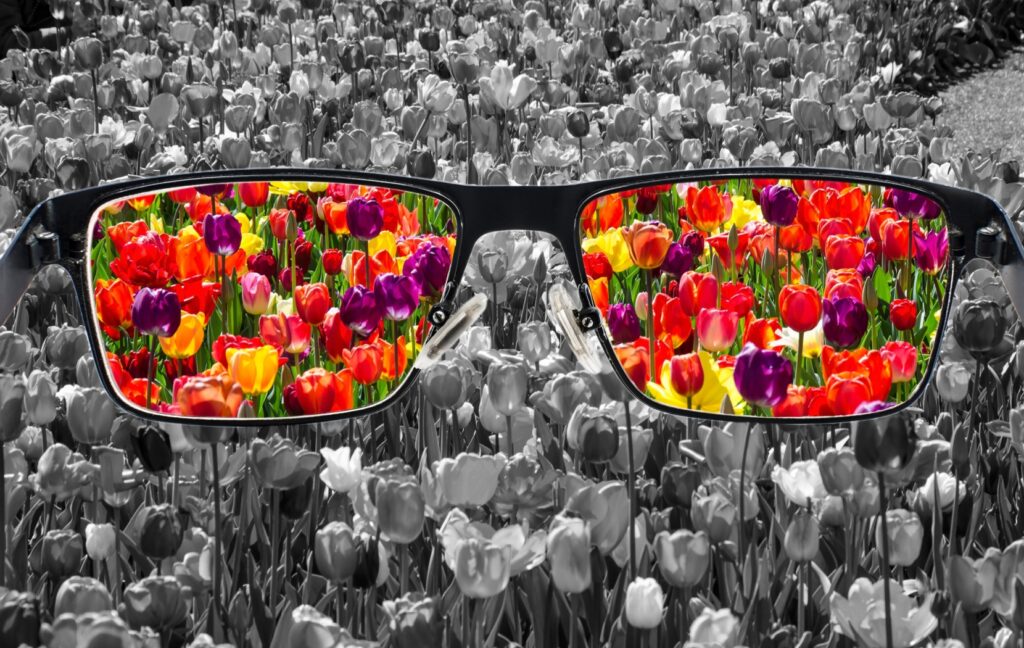Color blindness, or color vision deficiency, affects the ability to perceive certain colors or differentiate between them. Because traffic lights, road signs, and other driving cues rely on color coding, you might wonder whether being color blind presents a significant barrier to driving.
The simple answer is yes, people who are color blind can drive. However, color blindness impacts people differently; some individuals may need special accommodations to drive safely and maintain their eye health.
What is Color Blindness?
Color blindness is a genetic condition caused by a deficit or defect in the cone cells of the retina, which are responsible for detecting color.
Approximately 1 in 12 men and 1 in 200 women worldwide are color blind. While color blind individuals might not see as color as vividly or distinctly as someone with full-color vision, their ability to see clearly is usually unaffected.
Types of Color Blindness
There are different types of color blindness, including:
- Red-Green Color Blindness (Most Common): Difficulty distinguishing between red and green hues.
- Blue-Yellow Color Blindness: Difficulty distinguishing between blue and yellow shades.
- Total Color Blindness (Rare): Complete inability to perceive color.
How Does Color Blindness Affect Driving?
Certain driving scenarios rely heavily on distinguishing colors, particularly traffic lights, road signs, and lane markings. Here’s how color blindness can play a role in each:
Traffic Lights
One common concern among color blind drivers is recognizing traffic lights. Since they rely on red, yellow, and green lights to guide traffic flow, a red-green color deficiency may pose challenges. However, the position of the lights is standardized in most countries:
- Red is at the top or far left.
- Yellow is in the middle.
- Green is at the bottom or far right.
By paying attention to the placement of the lights rather than their color, color blind drivers can adapt and manage this challenge effectively.
Road Signs
Some road signs, such as stop signs, are designed with recognizable shapes and contrasting hues to assist all drivers, including those with visual impairments. For example:
- Stop signs are always octagonal, making them easy to identify even without relying on their red color.
- Warning signs are typically triangular, with bold lettering or symbols that don’t require color recognition to interpret.
Lane Markings
Road markings are often painted in white or yellow, colors that are distinguishable even for those with blue-yellow color blindness. This means that staying safely within lanes or interpreting directional arrows poses little difficulty.
Legal Requirements for Drivers with Color Blindness (Texas)
In Texas, drivers must meet certain vision standards to obtain a license—including tests for both visual acuity and color vision. These requirements are outlined in Texas Administrative Code § 15.51.
1. Vision Testing During Licensing
All original applicants must undergo an eye exam that evaluates:
- Visual acuity: A minimum of 20/40 vision in both eyes (with or without corrective lenses) is required for an unrestricted license.
- Color vision: Applicants must demonstrate the ability to distinguish between red, amber, and green traffic signals—a key safety requirement.
Failing the color vision test does not automatically disqualify an applicant from driving. However, further evaluation may be necessary to ensure the driver can recognize standard traffic lights safely.
2. What Happens if You Don’t Pass the Color Vision Test?
If a person cannot reliably identify traffic signal colors:
- The Texas Department of Public Safety (DPS) may refer them to an eye care specialist for additional evaluation.
- The driver may be asked to provide proof that they can safely operate a vehicle despite the deficiency—such as a statement from an optometrist or ophthalmologist.
- Alternatively, DPS may conduct a signal light test to verify the applicant’s ability to interpret traffic lights correctly.
3. License Restrictions (When Applicable)
If a color vision deficiency is severe or accompanied by other visual limitations, DPS may issue a license with specific restrictions, such as:
- Daylight-only driving
- Speed limits not exceeding 45 mph
Requirement to wear corrective lenses while driving
These measures are intended to ensure the safety of both the driver and others on the road.
4. No Special Equipment or Vehicle Markings Required
Texas does not require color blind drivers to use special adaptive equipment or display vehicle markers. However, many drivers voluntarily use tools like color-correcting glasses or traffic signal apps to boost confidence behind the wheel.
Tips for Color Blind Drivers

Color blind individuals can adopt strategies to ensure their safety and confidence while driving. Here are some helpful tips:
1. Learn the Traffic Light Sequence
Since traffic lights use fixed positions for each signal, practice associating the position of the light with the correct action (stop, caution, or go) rather than relying solely on its color.
2. Rely on Patterns and Shapes
Understand the shapes and patterns used on road signs. Memorizing these will help you quickly interpret critical information without depending on color.
3. Seek Adaptive Tools
Technology offers several helpful tools for color blind drivers:
- Color Blindness Glasses: Tinted glasses like EnChroma can enhance color perception, though their effectiveness varies between individuals.
- Traffic Signal Apps: Smartphone apps designed for color blind drivers can provide additional confidence by verbally describing traffic light colors.
4. Communicate with Driving Authorities
If you’re unsure about specific accommodations or driving laws, reach out to your local Department of Motor Vehicles (DMV). They can provide guidance and answer questions about color blindness and licensing requirements.
Driving Confidently with Color Blindness
Being color blind doesn’t mean you can’t enjoy the independence and freedom that driving offers. By understanding your condition, adopting proven strategies, and using helpful tools, you can safely hit the road.
At Eye Care Plus, we believe that every individual deserves support in achieving their goals, no matter their vision needs. If you or a loved one has concerns about driving with color blindness, schedule an eye exam today, and we’ll explore personalized solutions tailored to your vision.



